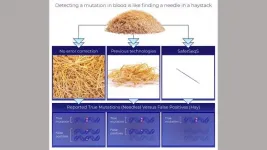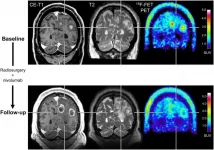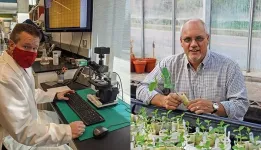(Press-News.org) Next-generation gene sequencing (NGS) technologies --in which millions of DNA molecules are simultaneously but individually analyzed-- theoretically provides researchers and clinicians the ability to noninvasively identify mutations in the blood stream. Identifying such mutations enables earlier diagnosis of cancer and can inform treatment decisions. Johns Hopkins Kimmel Cancer Center researchers developed a new technology to overcome the inefficiencies and high error rates common among next-generation sequencing techniques that have previously limited their clinical application.
To correct for these sequencing errors, the research team from the Ludwig Center and Lustgarten Laboratory at the Johns Hopkins Kimmel Cancer Center developed SaferSeqS (Safer Sequencing System), a major improvement to widely used technologies based on a previous technology called SafeSeqS (Safe Sequencing System) that Hopkins investigators invented a decade ago. The new SaferSeqS technology detects rare mutations in blood in a highly efficient manner and reduces the error rate of commonly used technologies for evaluating mutations in the blood more than 100-fold.
Their findings were reported May 3 in Nature Biotechnology.
The presence of a mutation in a clinical sample could be an early indicator that a person has developed cancer, says study lead author and M.D./Ph.D. candidate Joshua Cohen. Cancer is a genetic disease, driven by oncogenes and tumor suppressor genes. A small portion of cancer cells shed their DNA into the bloodstream, allowing their mutations to be detected via blood sample. Detecting such mutations in blood rather through surgical biopsy of a cancerous tissue is called "a liquid biopsy." Such blood-based tests have the potential to detect cancer at an earlier stage, when it can be put into remission by surgery and/or chemotherapy. The challenge, Cohen explains, is that the vast majority of DNA present in the blood sample is shed by noncancer cells, and only a tiny fraction of the DNA is derived from the tumor. In patients with relatively early-stage cancers, a 10 mL blood sample will only contain a handful of molecules with a mutation.
"To detect cancers when they have the best chance of being cured requires a detection method that will pick up cancer signals that are present at extremely low frequencies," says Cohen. "The technical challenge in detecting these mutations is akin to finding a needle in a haystack."
The researchers addressed this challenge, with SaferSeqS, by efficiently tagging both strands of each original molecule present in an individual's blood with a unique barcode. It required new biochemical approaches to do this in an efficient manner with the small number of degraded DNA molecules that are usually present in blood. The investigators use the structural redundancy of the double-stranded DNA molecule to distinguish real mutations from errors, an approach called duplex sequencing. If both strands of a DNA molecule contain the identical mutation, it is far more likely that it is a real mutation and not an error.
"What makes SaferSeqS unique is the efficient tagging of both strands of the majority of DNA molecules circulating in the blood, the low error rate achieved through analysis of both strands of these DNA molecules, and the manner in which the molecules of interest are enriched prior to sequencing. Altogether, these advancements underlie the power of the new technology," says Cohen.
"Every molecule is sacred because it has the potential to be the one with the mutation we're looking for," says Cohen. "Because the absolute number of molecules is low, the technology has to be highly efficient at capturing each molecule to sensitively identify mutations."
To test the specificity and sensitivity of SaferSeqS in a clinically relevant setting, the researchers compared the samples to previous results from the CancerSEEK test, a single blood test that screens for eight common cancer types, developed and reported by the same research team (Science, 2018).
The researchers revisited 74 blood samples from patients with cancer that had false negative results -- undetectable mutations -- in the 2018 CancerSEEK study using SafeSeqS. In their newest study describing SaferSeqS, the researchers reassessed these blood samples. Using SaferSeqS, they observed a marked improvement in sensitivity, finding previously undetectable mutations in 68% of the samples tested.
"The SaferSeqS strategy affords highly reliable technical specificity, which translates to a better way to provide clinically meaningful results for patients with relatively early-stage and small tumors," says Cohen.
Taking these results together, the researchers conclude that SaferSeqS is highly sensitive and specific for detecting extremely rare cancer-related mutations, is potentially efficient and cost effective for clinical use, and reduces the error rate of existing mutation-detection approaches more than 100-fold.
The next step, they say, is to validate the results and demonstrate the clinical usefulness of the technology in prospective clinical trials.
The researchers say SaferSeqS will be the underlying platform for future CancerSEEK studies.
INFORMATION:
Co-authors of the study include from Johns Hopkins Christopher Douville, Jonathan C. Dudley, Brian J. Mog, Maria Popoli, Janine Ptak, Lisa Dobbyn, Natalie Silliman, Joy Shaefer, Cristian Tomasetti, Nickolas Papadopoulos, Kenneth Kinzler and Bert Vogelstein; and Jeanne Tie and Peter Gibbs from the Walter and Eliza Hall Institute of Medical Research and University of Melbourne, Victoria, Australia.
The work was supported by the Lustgarten Foundation for Pancreatic Cancer Research, the Virginia and D.K. Ludwig Fund for Cancer Research, the Marcus Foundation, the Conrad N. Hilton Foundation, and the John Templeton Foundation; Victorian Cancer Agency Clinical Research Fellowship CRF14007 and Translational Research Grant; and National Institutes of Health grants T32 GM007309, U01 CA230691-01, P50 CA228991, U01 CA200469, R37 CA230400-01, CA62924, CA210170 and U01 CA152753.
SaferSeqS and CancerSEEK technologies have been licensed by Exact Sciences. Vogelstein, Kinzler and Papadopoulos are founders of Thrive Earlier Detection and Personal Genome Diagnostics and own equity in Exact Sciences. Kinzler and Papadopoulos are consultants to Thrive Earlier Detection, which was acquired by Exact Sciences in Jan. 2021. Kinzler and Vogelstein are consultants to Sysmex and Eisai. Kinzler, Vogelstein, and Papadopoulos are advisors to CAGE Pharma. Vogelstein is a consultant to Catalio, and Kinzler, Vogelstein, and Papadopoulos are consultants to NeoPhore. Papadopoulos is consultant to Vidium. Douville is a consultant to Thrive Earlier Detection. These and other companies have licensed technologies related to the work described in this paper from Johns Hopkins University. Cohen, Douville, Vogelstein, Kinzler, Tomasetti, and Papadopoulos are inventors on some of these technologies. Licenses to these technologies are or will be associated with equity or royalty payments to the inventors and Johns Hopkins University. Additional patent applications on the work described in this paper are being filed by Johns Hopkins University. The terms of all these arrangements are managed by Johns Hopkins University in accordance with its conflict of interest policies. The remaining authors declare no competing interests.
ROCHESTER, Minn. -- A pair of Mayo Clinic studies shed light on something that is typically difficult to see with the eye: respiratory aerosols. Such aerosol particles of varying sizes are a common component of breath, and they are a typical mode of transmission for respiratory viruses like COVID-19 to spread to other people and surfaces.
Researchers who conduct exercise stress tests for heart patients at Mayo Clinic found that exercising at increasing levels of exertion increased the aerosol concentration in the surrounding room. Then also found that a high-efficiency particulate air (HEPA) device effectively filtered out the aerosols and decreased the time needed to ...
Reston, VA--For patients with brain metastases, amino acid positron emission tomography (PET) can provide valuable information about the effectiveness of state-of-the-art treatments. When treatment monitoring with contrast-enhanced magnetic resonance imaging (MRI) is unclear, adding 18F-FET PET can help to accurately diagnose recurring brain metastases and reliably assess patient response. This research was published in The Journal of Nuclear Medicine.
Newer treatment options for patients with brain metastases--such as immune checkpoint inhibitors and targeted therapies--are effective, but can cause a variety of side effects. ...
The human immune system doesn't just protect our health, it reflects it. Each encounter with a potential disease-causing agent causes the body to produce specific immune agents -- proteins known as antibodies and T-cell receptors -- tailor-made to recognize and destroy the invader. Tasked with preventing re-infection, antibodies and T-cell receptors (TCR) from your previous encounters circulate throughout the body indefinitely, like a record of your personal medical history that you carry inside of you.
Clinical pathologist Ramy Arnaout, MD, DPhil, ...
WASHINGTON, DC -- A new case report, detailed in Annals of Emergency Medicine, is the first known case of a patient with VITT (vaccine-induced thrombotic thrombocytopenia) treated with a heparin alternative following the Centers for Disease Control and Prevention (CDC) guidance.
An otherwise healthy female patient in her 40s came to the emergency department at UCHealth University of Colorado Hospital twelve days after receiving the Johnson & Johnson vaccine with a headache, dizziness, and vision changes. The patient was treated on April 13, 2021, the same day that the Centers for Disease Control and Prevention (CDC) announced a pause in the administration of the Johnson & Johnson vaccine. CDC guidance recommended ...
You know that raw overwhelm people have been reporting after months of a pandemic, compounded by economic issues and social unrest? Does fatigue and compulsive social media scrolling strike a familiar chord?
Those brittle feelings offer us a glimpse into what regular life can be like for individuals with sensory processing sensitivity (SPS), a biological trait possessed by roughly a third of the population. In a world of constant information overload and stress, it's a characteristic that can result in a variety of behaviors, from emotional outbursts to withdrawal, overwhelm and procrastination.
"Behaviorally, we observe it as being more careful and cautious when approaching new things," said Bianca Acevedo, a researcher ...
Boulder, Colo., USA: The Geological Society of America regularly publishes
articles online ahead of print. For April, GSA Bulletin topics
include multiple articles about the dynamics of China and Tibet; the Bell
River hypothesis that proposes that an ancestral, transcontinental river
occupied much of northern North America during the Cenozoic Era; new
findings in the climatic history during one of the Earth's coldest periods:
The Late Paleozoic Ice Age; and the age an nature of the Chicxulub impact
crater. You can find these articles at END ...
PHILADELPHIA - Lung cancer is the third most common cancer in the U.S. and the leading cause of cancer death, with about 80% of the total 154,000 deaths recorded each year caused by cigarette smoking. Black men are more likely to develop and die from lung cancer than persons of any other racial or ethnic group, pointing to severe racial disparities. For example, research has shown that Black patients are less likely to receive early diagnosis and life-saving treatments like surgery. Now researchers at Jefferson have found that a commonly used risk prediction model does not accurately identify high-risk Black patients who could gain life-saving benefit from early screening, and paves the way for improving screenings and guidelines. The research was published in JAMA Network ...
A new study, published in JCI Insight, looks at how Brd4, a regulator of the innate immune response, influences diet-induced obesity. The researchers believe that Brd4 could be used as a target for obesity and insulin resistance.
Approximately one-third of the adults and one in five children in the U.S. have obesity problems. Unfortunately, the condition is also associated with the development of other diseases including diabetes, cardiovascular disorders, and cancer. "One of the biggest challenges we face is trying to understand how people develop obesity. If we can understand that, we can develop solutions for treating or preventing these diseases," said Lin-Feng Chen (MME), a professor of biochemistry.
The researchers investigated the role of the ...
The soybean cyst nematode (SCN) is the most damaging pathogen of soybean in the United States and Canada and it is spreading rapidly, according to information compiled by Gregory Tylka and Christopher Marett, nematologists at Iowa State University. SCN was first found in the United States in 1954 and most recent estimates show that SCN results in $1.5 billion in annual yield losses.
"The continuing spread of SCN is alarming, but not surprising," said Tylka. "Anything that moves soil can move the nematode, including wind, water, and farm machinery." ...
Educating athletes, parents and coaches about concussion treatment and prevention has been a priority during the last decade, but are the intended audiences hearing the message?
New research from the University of Michigan found that 1 in 4 adolescents self-reported at least one concussion in 2020, up from about 20% in 2016. During that same time period, youth who reported one concussion rose from roughly 14% to 18%, and those who reported at least two concussions increased from about 6% to 7%.
"Self-reported concussions could be increasing given that both children and parents have greater ...



